Figure 7.1 Members of the Committee with Australian Embassy officials Mexico City. 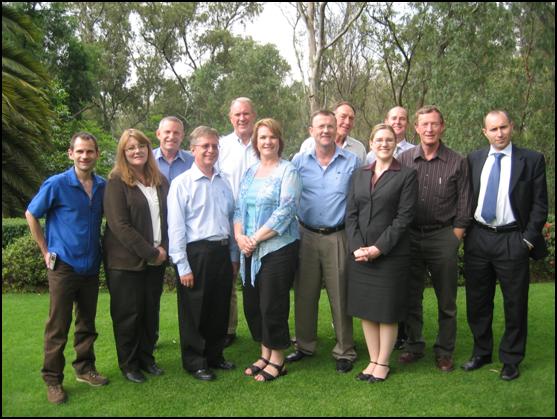
|
|
|
Overview |
| 7.1 |
The visit by the Trade Committee to Mexico proved very successful in terms of contacts made, opportunities identified and challenges addressed. |
| 7.2 |
The Australian Embassy in Mexico City, led by the Ambassador Mr Neil Mules, did an outstanding job in arranging a programme for the visit. The Ambassador used the opportunity of the visit for providing entrée to government ministers, senior government officials and business leaders. The committee was also the focus for a reception hosted by the Ambassador to which senior business executives from key importing and investing Mexican companies.
Key appointments
- Foreign Minister Patricia Espinosa
- Vice Minister for the Economy (Trade) Beatriz Leycegui
- Central Bank Deputy Governor Guillermo Guemez Garcid
- Mexican Council on Foreign Relations
- Education Department – Director General for International Affairs in the Education Ministry
- Mexican importers of Australian Cattle
Key Functions
- Luncheon with Senior Executives of Securency and the Bank of Mexico regarding Australian/Mexican joint venture in the production of polymer bank notes (20 and 50 peso notes).
- Luncheon hosted by Mexican Senate
- Reception with Australian – Mexican Business Community.
|
|
|
Outlook for Australian Trade - Overview |
| 7.3 |
A survey carried out by the Mexican Council on Foreign Relations highlighted that Australia is highly regarded by Mexicans. In terms of favourability Australia is ranked third behind the US and Canada. This is of considerable assistance to Australian exporters to this market. |
| 7.4 |
There is no doubt that trade with the USA dominates the Mexican trade scene. The US represents 80% of exports (90% of manufactured exports) and 50% of imports. 60% of the GDP of Mexico depends on the USA. Mexican business is not interested in diversifying when the reality is that when the US has a good year its growth is greater than the Mexican economy. There was a view at the senior levels of the Government that Mexico should diversify its trade so that it is not dependent on the USA. |
| 7.5 |
The opportunities for Australian exports exist predominantly in the energy, agricultural, education and mining equipment areas. |
| 7.6 |
Australia supplies steaming coal to a power station on the West Coast of Mexico. There are also real possibilities of LNG sales in the future. |
| 7.7 |
Agricultural sector exports are predominantly related to live cattle which have been averaging 10,000 – 15,000 impregnated cows each year worth $40 million. The experience of Mexican dairy producers has been very positive and the Australian importing company Elders is optimistic about the future prospects for Australian exports. |
| 7.8 |
In addition there has been a consistent increase in the number of students from Mexico coming to Australia for tertiary training. In 2005-06 the value of education – related services exports was A$27 million. Bilateral agreements have been reached with University of Queensland, Macquarie University and Griffith University and Mexican Universities. |
| 7.9 |
It would also appear that opportunities exist for Australian mining equipment in the significant Mexican mining activities. Where five years ago there were 3 producing mines, there are now 55. |
| 7.10 |
The Australian company Orica has also established a significant market for explosives in Mexico. Orica already has an investment of $100 million in Mexico. The company is currently planning a world conference in Mexico. |
| 7.11 |
Australian wine has performed well in Mexico. In addition Austrade representatives in Mexico are optimistic about the opportunities for gourmet foods and groceries. The joint agreement between the Australian Reserve Bank and the Bank of Mexico is producing significant income through the production of 20 and 50 Mexican peso notes on polymer notes. |
| 7.12 |
There are approximately 30-40 million members of the ‘middle class’ in Mexico which provide a significant potential buying power for Australian products. |
| 7.13 |
Much attention was given during the visit to the takeover bid by the very large Mexican company of the Australian company Rinker. This is the largest ever takeover offer by any Mexican company. |
|
|
Potential Free Trade Agreement |
| 7.14 |
Following preliminary feasibility discussions between Mexican and Australian trade officials held in Adelaide two weeks before the committee’s visit to Mexico, some reference was made during the visit to a potential free trade agreement between Mexico and Australia. It would appear that key Mexican Ministers and officials are cautious about this possibility. |
| 7.15 |
The reality according to Mexican Government Ministers is that the intention is to deepen and broaden Mexico’s existing FTA’s rather than begin negotiating new agreements. Mexico already has over 40 FTA’s in existence, amongst the highest held by any country. In addition this year the final stages of the NAFTA agreement are being implemented and as a result there is some sensitivity in Mexico to the final cut in tariffs which are part of the agreement. |
| 7.16 |
Senior Mexican officials encouraged the committee to persuade Mexican business leaders of the value of an FTA with Australia. |
|
|
Appointment Summary |
Minister for Foreign Affairs, Patricia Espinosa |
| Figure 7.2 Minister for Foreign Affairs, Patricia Espinosa and the Chair, Hon Bruce Baird MP |
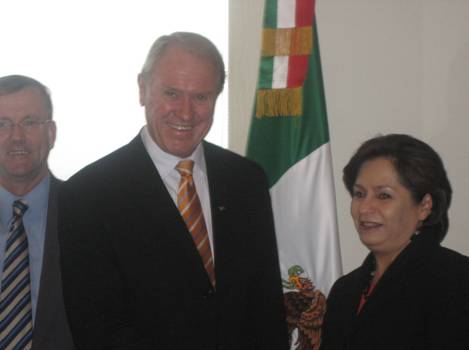 |
| |
- Outlined that policies used to be determined by the President and rubber stamped by Congress. Today, according to the Minister the approach is more co-operative and is based on consensus building, and the Mexican Senate now has more power in relation to treaties and agreements.
- Macro-economic indicators strong and the economy is solid.
- According to the Minister the challenges to the Mexican economy are:
- Mexico has lost its competitiveness compared with China
- The economy needs to open up and structural reforms are necessary.
- The Minister saw similarities between Australia and Mexico in relation to economic size and the diversity of our economy. And that both countries can complement one another.
- Australia is seen by Mexico as a friendly, open and inclusive society.
- Other structural reforms the Minister believed were important were tax and labour reforms particularly in the mining and energy sector.
- Mexico placed importance on APEC and looked forward to developing its relationship with Australia during the process.
- The challenge for Mexico in developing its trade relationship with the Asia Pacific area is to encourage businesses involved in the region and in joint ventures to educate Mexican society that opportunities exist in areas other than North America.
|
Vice Minister for the Economy, Beatriz Leycegui |
| |
- The Minister commented on the possibility of a FTA with Australia - that there was still a long way to go and that the view had developed in the Mexican business community that they should keep existing FTA’s and deepen them, rather than negotiating new agreements.
- The challenge for Mexico according to the Minister is improving its competitiveness. She cited the need for greater flexibility in issues such as rules of origin.
- The Minister outlined her view as to the best opportunities for two-way trade between Australia and Mexico lay in the area of coal, mining, education, wine, tourism, livestock and agriculture.
- The Minister indicted that the moratorium on negotiation of new FTA’s was a result of protectionist sentiments predominately in the private sector. The fact that the final stage of tariff protection under NAFTA was being undertaken this year meant there were heightened sensitivities in the Mexican business community. There was strong resistance from the agricultural sector to the full implementation of NAFTA particularly the elimination of tariffs on corn, beans and powdered milk taking effect in 2008.
- The Minister advised that sensitive agricultural producers would need to be convinced of the benefits of an alliance with Australia. The Congress now has an enhanced role in relation to approving any new FTA’s and they would also need to be convinced.
|
Ministry of Education |
Carlos de Alba, Director General for Internal Affairs in the Education Ministry |
Figure 7.3 Members of the Committee attend a meeting with Carlos de Alba.
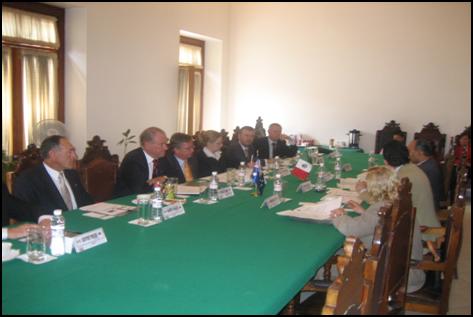
|
| 7.17 |
The Director General spoke of the co-operation between Mexico and Australia in expanding its own vocational and technical training. The Director General indicated that the Mexican Government wanted to reduce its over-reliance on U.S. universities and colleges. MOU’s had been negotiated with University of Queensland, Griffith University and Macquarie Universities based on a sister city concept. |
| 7.18 |
Opportunities existed for Australian universities in mining training, multiculturalism and tourism, fishing and agriculture as well as TAFE related technical courses. |
| 7.19 |
They were also interested in developing a relationship between Mexico and Australia in long distance education and an exchange program for Spanish and English language teachers. |
|
|
Bank of Mexico (Central Bank) |
Guillermo Guemez, Deputy Governor of Bank of Mexico |
| 7.20 |
This briefing provided the delegation with a comprehensive overview of the Mexican economy. |
| 7.21 |
The Mexican economy has become more open as a result of the multiple FTA’s negotiated in recent years. NAFTA is the most significant FTA with the U.S. accounting for 90% of manufactured exports. Because of competition with China, Mexican industry has had to restructure. In particular Mexico has shifted from highly labour intensive industry to more sophisticated exports. Imports are now growing in several market segments namely:
- Fashion textiles. Mexico is specialising in high end fashion and has the possibility to respond more quickly to fashion changes compared with China.
- Any high tech product
- Products which are difficult and costly to transport to the U.S. from Asia; particularly refrigerators and washing machines. Currently 6,000 refrigerators are being produced every week close to the U.S. border.
|
| 7.22 |
The Mexican economy is slowing in response to the slowing of the U.S. economy. As a result the growth of the Mexican economy this year is expected to be 2-3%. |
| 7.23 |
In Summary the Deputy Governor saw several areas that needed structural change: |
Political |
| 7.24 |
The Deputy Governor stated that political changes were needed. The current 3 party system means agreement on issues is difficult and the fact that members of parliament are elected for only one term creates problems of accountability. |
Fiscal |
| 7.25 |
Currently 29% Corporate tax rate with almost no deductions. |
| 7.26 |
Government intervention in the economy – For 40 years the Mexican economy has been influenced by government intervention. In 1992 60% of the Mexican GDP was government related. |
Diversity of Industry |
| 7.27 |
Currently 30% of the Government budget comes from the oil industry. |
Labour/IR |
| 7.28 |
Teachers have a salary for life and retirement security. |
Energy |
| 7.29 |
Electricity prices are higher than in the U.S. Mexico only has one tariff. When the world oil price goes down, the Mexican price goes up. |
| 7.30 |
The Mexican electricity company has no employment incentive. |
| 7.31 |
There is mandatory union membership for companies involved in the mining, sugar and communications sectors. |
Drugs |
| 7.32 |
Are a real problem for Mexico. The value of the overall drug market in the US is worth half of Mexico’s GDP and most comes through Mexico. This creates a criminal issue but the Mexican political leadership is addressing the issue head on. |
Other Issues |
| 7.33 |
- Believed that Mexico needs to diversify as industry is very US centred.
- Next year growth is expected to grow 4% and the year after 4.5%.
- Unemployment is expected to increase by 1% caused by more areas of society trying to come into the workforce particularly women.
- This year 600,000 new jobs are expected to be created, particularly with growth in silver, copper and lead production.
- Inflation this year expected to be 3-4%.
- Inflation in 1995 reached 50%
- Interest rate currently 7% and revenues US $70 billion.
|
|
|
Mexican Council of Foreign Affairs |
| 7.34 |
The group published a commissioned survey on the attitude of Mexican citizens to 30 countries. This survey ranked Australia third, which is a remarkable achievement. |
| 7.35 |
The biggest problem for Australia is the dominance of the USA in terms of Mexico’s trade – 80% of exports and 50% imports. |
| 7.36 |
This is a difficult year for Mexico in that this is the last transitional year in reduction of the tariffs as part of NAFTA. |
| 7.37 |
Various challenges for Mexico
- Infrastructure particularly lack of port facilities
- Political – while Mexico has been a democratic success of young institutions but it is in a period of evolution. Whilst there has been an increasing role for Congress and the executive - Congress are learning how to work together. There is also an increase in executive power.
|
| 7.38 |
There is also an important challenge in terms of structural reform particularly in relation to structural reform of labour and taxation.
- There is a need for the reform of the State Pension System.
|
| 7.39 |
Mexico is not a Parliamentary majority. No single party has a majority in Congress. |
| 7.40 |
The justice system also needs reform. The Supreme Court has been involved in constitutional conflict. |
Mexican Senate |
Figure 7.4 Memebers of the Committee at a working lunch organised by the Mexican Senate.
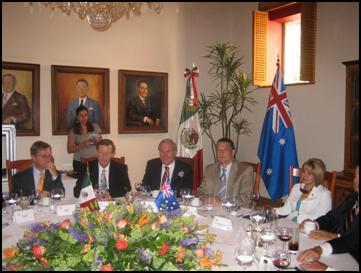
|
| 7.41 |
The Committee met with representatives of the Mexican Senate at a working lunch. The presiding Senator spoke about the opportunities for further dialogue with Australia this year during Australia’s hosting of APEC. They also discussed the forthcoming visit to Australia of representatives of the Mexican Congress. Representatives from both Parliaments agreed on the potential for further collaboration in mining agriculture, wine, tourism and education. Discussions were also held on a potential FTA between Mexico and Australia. |
| |
|
Embassy Reception |
| 7.42 |
The Australian Ambassador to Mexico hosted a reception attended by representatives of companies doing business in Australia including CEMEX and GRUPO MODELO (Corona Beer). |
| |
|
Visit to Quetetaro |
| 7.43 |
The delegation visited a dairy farm in Queretaro which has 2000 head of cattle, 80% of which were imported from Australia. One of the key people meeting the delegation in Queretaro was the President of the Livestock Committee of the Mexican Lower House, Mr Francisco Dominguez, to discuss opportunities for co-operation in the agricultural sector. |
| 7.44 |
The Committee also met with representatives of Securency in Queretaro to discuss the company’s plans to build a bank note printing company in a $30 million joint venture with a Bank of Mexico. |
Figure 7.5 Members inspect a dairy farm in Queretaro.
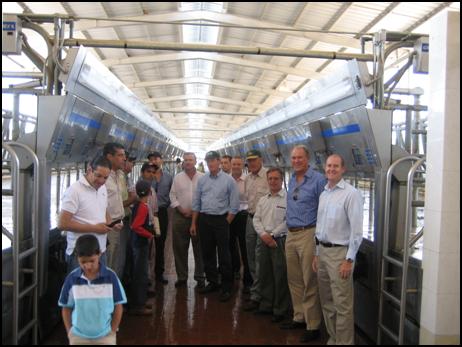 |